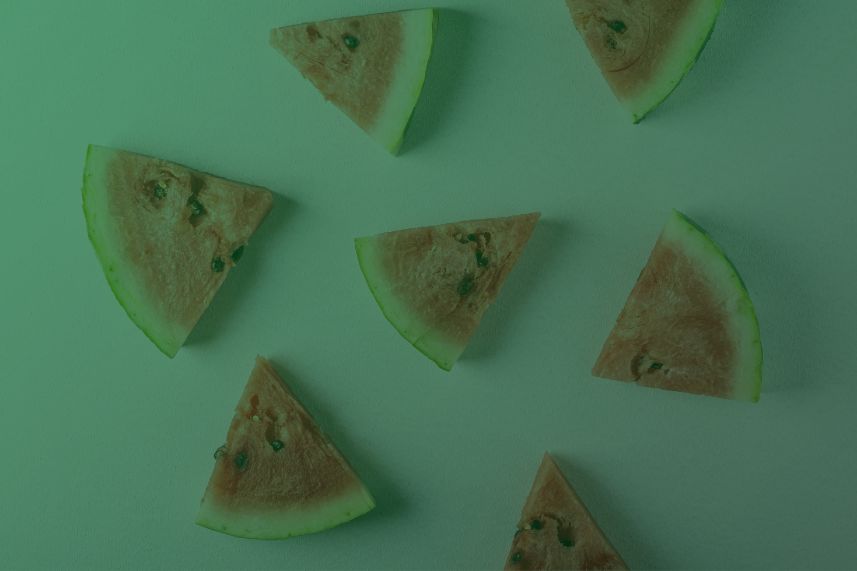The “Palestinian Watermelon” carries an intriguing story. Amid social media content blockades by Meta, TikTok, and Twitter, many netizens are championing the truth about Palestine using the watermelon symbol. This symbol has become one of the ways to outsmart social media algorithms. But what does the watermelon symbol mean? Where did it originate from? And how did it become so viral?
The History of the Palestinian Watermelon Meaning
The Palestinian watermelon campaign first emerged after the Six-Day War in 1967, when Israel fought against the United Arab Nations comprising Egypt, Syria, and Jordan. At this time, Israel took control of the West Bank, Gaza Strip, and captured East Jerusalem. Israeli Zionists enacted laws stating that raising the Palestinian flag in public places was a criminal act. Israel implemented these rules to suppress Palestinian and Arab nationalism. As a result, the Palestinian community used the image of a watermelon as a symbol of resistance against Israel, incorporated into art, shirts, graffiti, murals, and posters.
The Meaning of the Palestinian Watermelon in Artists’ Works
In 1980, Israeli soldiers closed 79 galleries displaying works by artists Sleiman Mansour, Issam Badr, and Nabil Anani, considering their works political and containing colors of the Palestinian flag. Even art pieces featuring watermelons were confiscated, highlighting Israel’s fear of the nationalist spirit and resistance continually voiced by the Palestinian people. They confiscated all artworks using the colors of the Palestinian flag.
Following the Oslo Accords in 1993, which aimed to reconcile Palestine and Israel, the ban on using the Palestinian flag was lifted. The agreement was signed by Yasser Arafat, the Chairman of the Palestine Liberation Organization (PLO); Yitzhak Rabin, the Prime Minister of Israel; and witnessed by Bill Clinton, the President of the United States. However, in 1996, this agreement was frequently violated by Israel to obstruct Palestinian independence.
Inspired by the watermelon story, artist Khaled Hourani created a piece featuring a watermelon slice titled “Subjective Atlas of Palestine” in 2007. This artwork was exhibited in various countries, including Egypt, Jordan, Scotland, and France. Khaled Hourani’s work inspired other artists to create various watermelon-themed pieces conveying social messages about Palestine.
Baca Juga: Baitul Maqdis, Tanah Suci dan Kiblat Ketiga dalam Islam
Israel’s Sensitivity to Palestinian Flag Colors
In 2021, Israel banned the sale of watermelons in several occupied territories, considering the watermelon symbol as Palestinian provocation and propaganda. Israel confiscated and discarded watermelons cut into triangles and arrested Palestinians using the watermelon symbol.
Twenty years after the flag ban was lifted, in January 2023, Itamar Ben-Gvir, the right-wing National Security Minister of Israel, banned the use of the Palestinian flag in public places and instructed the police to confiscate the flags. In June, a law was enacted prohibiting the use of the Palestinian flag in various Israel-funded institutions. Despite numerous bans and restrictions imposed by Israel, the Palestinian watermelon campaign continues to grow and spread globally.
Baca Juga: Masjid di Palestina yang Sulit Dikunjungi Penduduknya Sendiri
The Role of Social Media in the Israel-Palestine Conflict
Social media plays a crucial role in colonial situations, serving as a tool for propaganda or advocacy for the oppressed. In the current Palestinian situation, social media is used as an educational medium to reveal the truth behind Israel’s propaganda news. Israel also uses mass media and social media for propaganda, justifying its colonization and bombing attacks on Palestine.
Hamas’s attack on Israel on October 7, 2023, caused panic and overwhelmed Israel. Hamas aimed to free 5,200 Palestinian detainees held by Israel without trial. The attack led Israel to indiscriminately bombard Gaza’s civilian population and arrest about 4,000 Gaza workers in Israel, along with 1,070 others in the West Bank, bringing the total number of Palestinian detainees to over 10,000.
The genocide committed by Israeli soldiers against Palestinian civilians has garnered global attention. The hashtag #freepalestine has been used over 5.2 million times, and the hashtag #gazaunderattack has been shared more than 1.7 million times on social media.
Baca Juga: Fakta Konflik Israel Palestina yang Penting Diketahui
Global Netizens Use the Watermelon Symbol as a Form of Support
Strong social media support has led to public demonstrations worldwide, advocating for Palestine. As support for Palestine intensifies, the US and Israeli governments are increasingly trying to silence public voices.
Efforts include spreading false information through mass media and social media, hindering and destroying the careers of workers and artists supporting Palestine, paying influencers to defend Israel, and manipulating social media algorithms to limit posts supporting or discussing Palestine.
Meta even blocked accounts with large followings discussing the truth about Palestine. All keywords related to “Palestine,” “Gaza,” “#freepalestine,” and the Palestinian flag icon were blocked from non-follower accounts.
In the first three days of the Gaza attack, Meta admitted to removing 795,000 Instagram contents. They also closed Palestinian defender accounts without prior notice. To outsmart algorithms, netizens use algospeak when discussing Palestine and Israel. Algospeak involves creating new words or codes to replace original terms, making conversations unrecognizable by algorithms. Examples include “G@z4,” “P4l3s+ina,” and “i5r4el” for Gaza, Palestine, and Israel.
The watermelon icon is not on Instagram’s censorship criteria list. Therefore, accounts using the watermelon symbol as a substitute for “Palestine” have minimal risk of restrictions. However, it’s essential to accompany the watermelon symbol with educational content related to the truth about Palestine to ensure the meaning of the Palestinian watermelon doesn’t become a temporary trend and lose its significance.
Baca Juga: Palestina Merdeka, Benarkah Pertanda Kiamat?
The Meaning of the Palestinian Watermelon in Humanitarian Solidarity
The watermelon consists of red flesh, black seeds, and white and green rind, representing the colors of the Palestinian flag. Additionally, watermelons are a staple crop in Palestine, thriving from Jenin to Gaza.
Interestingly, watermelons were also one of the Prophet’s favorite foods, as mentioned in a Sahih Hadith, “Indeed, the Prophet Muhammad often ate watermelon with ruthab (fresh dates).” (Narrated by At-Tirmidhi No. 1843, authenticated by Al-Albani in Sahih At-Tirmidhi No. 1843).
Watermelons have numerous seeds. When the fruit is crushed, many seeds fall to the ground, giving rise to new watermelons. This analogy reflects the resilience of the Palestinian people. Despite years of oppression and destruction, they remain strong-willed and resilient.
Baca Juga: Donasi Palestina, Namun Waspada Penipuan!
Support Palestine with Donations Through Dompet Dhuafa
The watermelon symbol serves as a form of internet community support for Palestine. Even sharing truthful information about Palestine is considered a virtuous act by Allah, as stated in the Quran, Surat Az-Zalzalah verse, “So whoever does an atom’s weight of good will see it.”
The people of Palestine in Gaza and the West Bank greatly need our solidarity as fellow humans. Besides participating in the Palestinian watermelon campaign, we can express our solidarity through direct assistance to those affected. Friends can contribute to supporting Palestine, helping them rise from adversity to achieve victory and independence.




